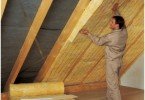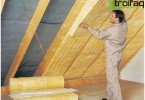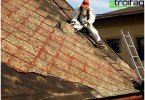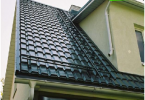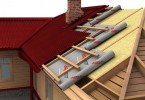Roofing Sandwich Panel
Roof sandwich panels – ergonomic material consisting of two cold-rolled steel sheets protected by a polymer coating. But the main secret of these unique products is the fact that there is a heat-insulating filler between the sheets, for example, polyurethane, mineral wool. This is a worthy alternative to traditional roofing materials, becoming more and more popular. But what significant advantages have a sandwich panel, how they are laid on the roof, we will tell further.
Content
- Important Information About Sandwich Panels
- Advantages of sandwich panels – why their application is now relevant?
- Types of polymer coatings for roofing panels
- Features of the installation of roofing products – valuable tips
Important Information About Sandwich Panels
Sandwich panels are multilayer products consisting of galvanized steel sheet and insulation.
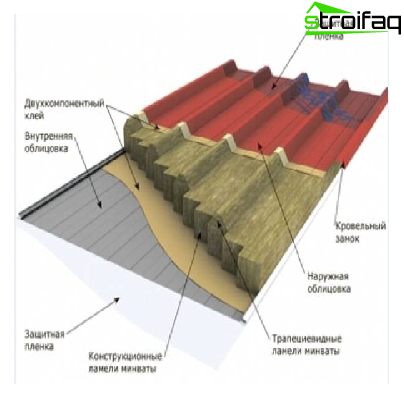
Sandwich panel device – a design thought out to the smallest detail
These are completely ready-to-use materials that do not require external / internal processing, that is, they can be used immediately after manufacture in the factory.
This is important to know: the quality of roofing panels is influenced by the manufacturing method, because the best products are obtained by assembly on an automatic line.
In the production of sandwich panels, the effectiveness of the glue, with which all components of the structure are connected and become a single element, is of great importance. Two-component polyurethane glue is used on automatic lines: it is mixed before application on glued surfaces, and the whole process is controlled by programmed automation.
It is worth paying attention: when choosing a metal lining, it is better to give preference to a light range, because then the sunlight reflects well, and the sandwich panel heats up and deforms less.
This building material is used in the arrangement of structures constructed according to the frame-panel scheme. If we consider this point in more detail, it should be noted that the panels are used in the construction of such objects:
- agricultural buildings (vegetable stores, poultry farms);
- logistics centers;
- administrative premises;
- sports complexes, pools, arenas;
- gas stations, car washes;
- power supply facilities.
Advantages of sandwich panels – why their application is now relevant?
The use of these building materials is advisable for many reasons, among which the following aspects should be mentioned:
- high thermal insulation characteristics;
- light weight – reduced costs for loading, unloading, delivery;
- cost savings on the foundation – the complex use of roofing, wall panels does not require geological research, because they do not exert significant pressure on the foundation;
- durability – the life of the panels is more than 20 years;
- resistance to corrosion, to aggressive environment;
- sandwich panels roofing sizes can have different, depending on the wishes of the customer. But the standard sizes are as follows: thickness 40-160 mm, length – up to 16000 mm, width – 1000 mm;
- varied colors;
- speed, ease of installation – the work is carried out by a small team in the shortest possible time;
- environmental safety – this fact is confirmed by the fact that sandwich panels are widely used in refrigerators, freezers, as well as in “clean” rooms;
- aesthetic appearance.
Separate attention needs to be paid to some more important nuances. Firstly, sandwich panels with mineral wool and polystyrene foam as the basis increase noise insulation. Secondly, the reliability of the lock connection is very much appreciated. The most modern and practical is the Z-Lock, suitable for vertical, horizontal installation. The advantages of using such a lock connection are obvious:
- joint tightness – this parameter is achieved due to the absence of holes. The anticapillary effect, which is caused by the great depth of the rolled part of the metal, by reverse profiling, is also important;
- ease of installation, tightness of the lock;
- increased level of protection against damage;
- the possibility of using sealing tapes.
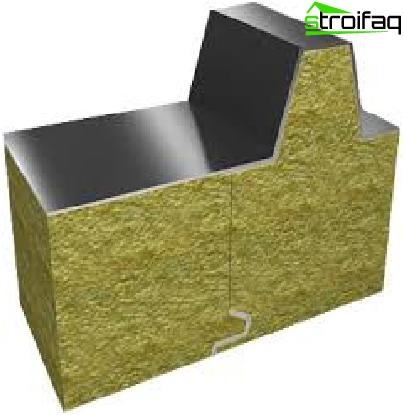
Z-Lock – state-of-the-art technology for maximum tightness
The type of heat insulating core also matters because materials have different properties. For example, when it comes to mineral wool, the following positive qualities are implied:
- minvata – fibrous material obtained from basaltic rocks;
- incombustibility – compliance with safety rules;
- optimally suitable heat and sound insulating properties;
- resistance to deformation;
- biological resistance, durability;
- compressive strength increases with increasing number of vertically oriented fibers.
Expanded polystyrene is also often used as a heat insulating core, because it has the following advantages:
- low thermal conductivity;
- excellent strength – the material is used as elements capable of carrying loads over a long period;
- moisture content – 3-6%;
- when burning, carbon dioxide and water are formed, that is, this material does not support combustion.
Sandwich panels have some limitations in terms of walking on the roof. You can walk on the panels, but for this, wooden ladders should be laid at right angles to the span. In general, the panels can’t be categorically used as a work platform and can only be walked on if absolutely necessary.
Types of polymer coatings for roofing panels
In order to protect metal panels from corrosion and environmental influences, various polymer coatings are used in the production of sheet steel. We will name the most common:
- polyester – a popular coating that gives the sheet resistance to ultraviolet radiation, to corrosion processes;
It is important to know: material with such a coating can be successfully used in any regions of the country.
- Pural – in the process of coating production, polyurethane and modified polyamide are used. Steel coated with Pural tolerates daily temperature changes and retains its original color for a long time;
- polyvinylidene fluoride is a durable coating that practically does not fade and has a unique ability to self-wash. This is one of the most durable coatings used even on the coast..
Features of the installation of roofing products – valuable tips
A set of works related to the installation of sandwich panels should be carried out taking into account the project, which contains information on the method of fastening the panels, on the type of fastener, on its quantity. In order for everything to be done at the proper level, you need to know the intricacies of laying these products, in particular, these rules are in mind:
- panels are lifted using special equipment (vacuum lifts);
It is important to know: gripping a sling over the surface of the panel is unacceptable.
- panels are cut with an electromechanical jigsaw;
- between the supporting structure and the panel, laying of a tape acting as a sealant is desirable;
- installation cannot be done if the wind speed is more than 9 m / s or when there is a thick fog;
- the protective film on the inside is removed before installation;
It is worth paying attention: on the outside of the panel, the film must be removed after the installation process.
- shaped elements are used for additional protection of adjacencies from the negative environmental impact.
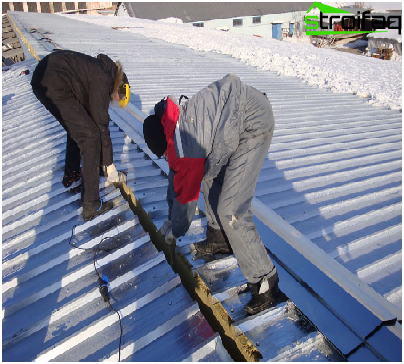
Installation of roofing panels must be done competently.
It should also be noted that the film is removed quite easily if the storage mode of the products was observed. In the case when excessive adhesion is observed, the following actions must be carried out:
- heat the surface of the panel with a hair dryer or heat gun;
- remove the film;
- remove adhesive residues with solvent.
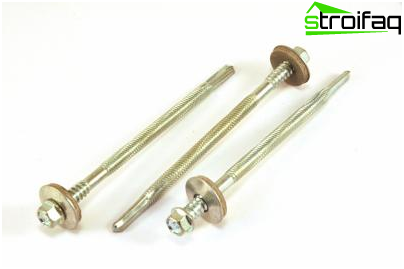
Sandwich panel screws do not require pre-drilling
A few words must be said about the self-tapping screws that are used for fastening panels. Their main feature is the presence of two threads: the first fastens the panel to the structure, the second is designed for rigidly fixing the outer sheet in order to prevent its vibrations. Self-tapping screws are made of carbon galvanized steel and are characterized by ductility, corrosion resistance.
This is important to know: to solve the sealing problems, a sealing washer is used in the base of the self-tapping screw.
Roofing sandwich panels made of steel sheets have many positive indicators, so they are widely used, and their popularity is steadily increasing..


